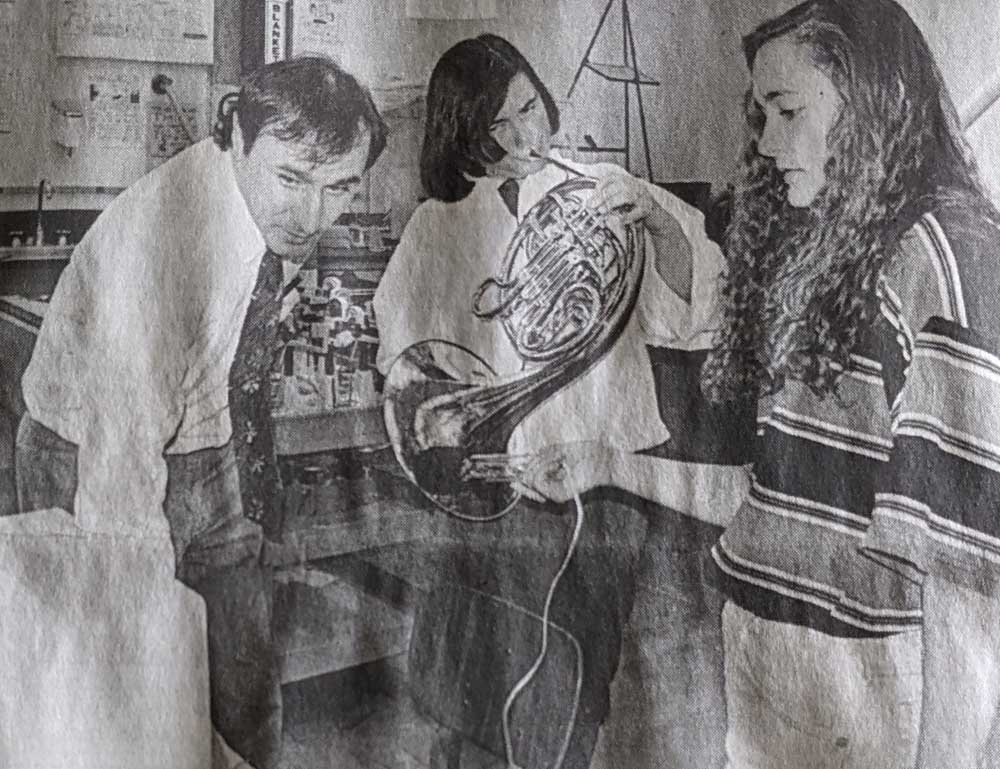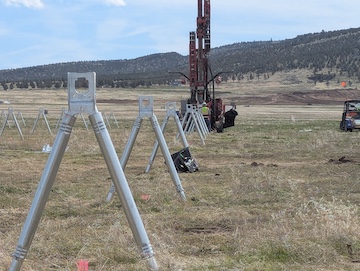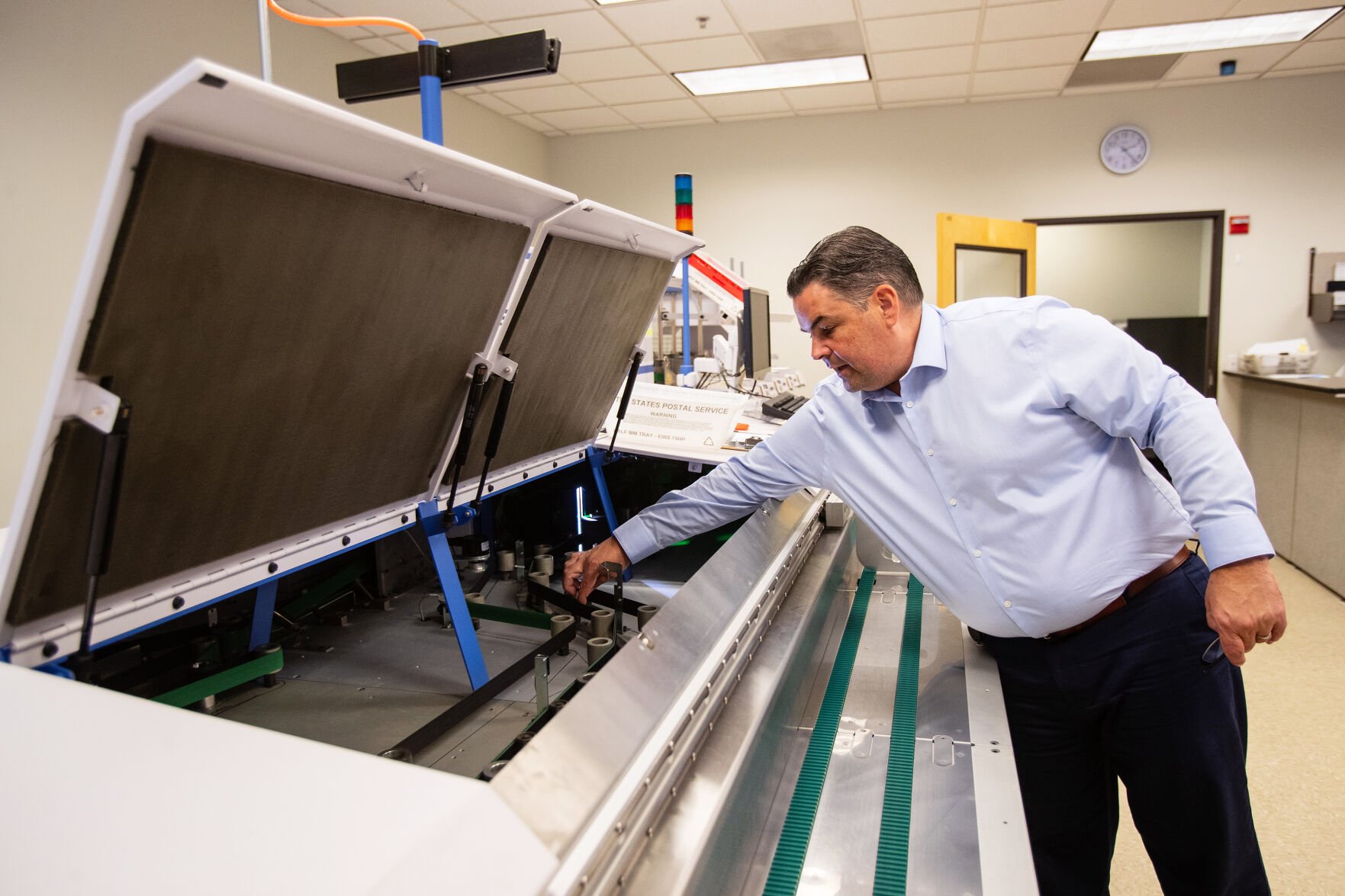Flashback: Getting in tune with physics
Published 1:00 am Wednesday, April 14, 2021

- Kristy Merck (right) records sound waves from French horn played by Kara Blair as physics instructor Ron Caramella monitors computer screen read-out.
100 years ago
April 14, 1921 — High School Students Lost In Tetherow Bridge Country Wander All Night in Rain
Miss Beryl Brown, John Hanson, Sweney Westesen, Redmond high school students, became lost Sunday night in the rough country adjacent to the Deschutes river about six miles northwest of Redmond and spent the night tramping through sagebrush and junipers in a cold rain.
Leaving a picnic truck which ran out of gas on the way home from Opal Springs where they and several other students had spent the day, the three students attempted to reach the Helmholtz farm house to get gasoline.
Other members of the party were left at the road shortly before nightfall, and although they had little more than half a mile to go by a “short cut,” they lost their way and were unable to get their bearings until daybreak.
They arrived at the Helmholtz home at 7 o’clock just as a searching party of parents who had been out nearly all night, and breakfasted and were preparing to again take up the search.
After several hours wandering, Hanson had climbed several juniper trees along their path in an effort to learn their whereabouts but was unsuccessful. Later on in the night they tired completely and built a fire.
Once Hanson slipped in the dark and fell several feet off a cliff. After that the three walked arm in arm.
Endeavoring to find the lost students, the searchers themselves had difficulty in keeping their direction and were twice temporarily lost in the intense darkness brought on by the rain, according to Edward Brown manager of the Redmond creamery, father of Miss Brown.
Remaining at the auto truck were Miss Dorothy Royal and Miss Hazel Caughey and Harry Hansen, George Johnson and John Bates. They obtained gasoline after waiting several hours and arrived in Redmond at 11 o’clock to tell of the disappearance of the other members of their party.
Miss Brown returned to Redmond and attended her classes Monday. The boys were absent.
75 years ago
April 18, 1946 — Use City Dump, Police Request
“It’s clean – up time, true enough,” says Chief of Police Jess Edgar, “but that isn’t the signal for hauling trash into the junipers east of Redmond.”
Redmond has a city dump, just as close to town as the area to the east, and the dump is the place to put garbage.
Last year, city officials were much concerned because the area east of town became an eyesore and health menace when vast amounts of garbage, carcasses and trash were dumped there.
All residents are urged to use the city dump, not the junipers to the east.
50 years ago
April 14, 1971 — Roberts Field gains air traffic control trainees
Two students from Mt. Hood Community College are getting their first taste of air traffic control at Roberts Field.
For the young men, both sophomores majoring in air traffic control and professional pilot, it is an opportunity to put into practice some of the book learning from campus, and a chance to find out if working for the Federal Aviation Administration is really their “bag.”
For the federal government, hiring Virgil Dahrens of Gresham and Bill Meyer of Portland as GS-3’s for three months on-the-job status in cooperation with MHCC is far less expensive than giving them 2 1/2 years of government financed training, only to learn that air traffic control wasn’t what they wanted and have them quit.
And, according to Flight Service Chief J.B. Malloy, the students’ presence at Roberts Field represents some real benefits locally. The program, which began last year nationwide, places the trainees at airports during their busiest season — spring and summer.
Where Malloy would normally be mapping out schedules now to double up FAA personnel, often requiring overtime during the seasonal rush, the students will be able to assume some of the duties. And where regular personnel may have been denied summer vacations, Malloy says those too will now be available.
Dahrens and Meyer primarily will be learning to transcribe aviation weather broadcasts, the teletypewriter function, and after they have been certified by the U.S. Weather Bureau, weather observations. Malloy notes that when the students appear knowledgeable enough, he will send for the weather bureau exams which must be passed to obtain certification.
Due to the close supervision required, the trainees will receive the least exposure to in-flight communication between the tower and aircraft.
Malloy pointed out that the emphasis is placed on training the students for time-consuming functions, releasing the regular specialists for the more complex tasks, thereby enabling the service to get through the peak season without cutting corners on service.
25 years ago
April 17, 1996 — Getting in tune with physics
Physics. If the word conjures up a bespectacled professor with pants pulled up to his armpits, a blackboard covered with numbers and equations and students furiously scribbling in notebooks, think again.
In Redmond High School’s physics class the teacher doesn’t wear glasses, his pants fit around his waist, the blackboard is a white board and it’s more likely to contain drawings that rows of math.
Although, instructor Ron Caramella says, “We do have days of working equations too.”
But Caramella’s students are more likely to be working at computers or cutting, drilling and grinding scraps of metal tubing. Then again, they might be tuning and playing musical instruments.
Wait a minute: Is this band or physics?
It’s physics.
The instruments are all part of what Caramella calls conceptual physics.
Traditional physics compares relationships through the use of formulas to solve problems, he said. By contrast, in conceptual physics, students spend more time figuring out why something happened.
Caramella, a 13-year veteran physics teacher at RHS, said the new approach means students are learning a lot more.
Five years ago, a similar class would study similar principles but wouldn’t have applied the theories to “something we’re all familiar with,” he said.
Caramella hopes that by teaching the concepts of physics through fun projects, more students will discover they can master difficult material.
In the case of the current physics-of-sound unit, teams of students are building wind chimes — a similar set sells on the internet for $25 — using the principles of physics to tune the pipes to a pleasant sound and exploring why some notes are melodic and others are sour.
They begin their exploration by striking random lengths of conduit pipe. When the expected low note didn’t happen, Caramella asked them to figure out why.
Using a microphone plugged into a computer, students became immersed in graphing sound waves, testing for frequency and learning about harmonics and resonance.
“A trumpet has a more erratic timbre than the pure tone of a flute,” senior Skye Mayo explained.
Mayo, who is taking as much math and science as he can, said the class seems more practical than some others he has taken. “It can explain what’s happening around me.”
The next step for the students was to put their knowledge to work.
Each team cut three conduit tubes to random lengths. Using the computer and wall charts, the students then figured the frequency and approximate note pitches, junior Josh Slay explained.
To fine-tune the chimes, the students slowly and carefully ground the tubes shorter until they rang with the right pitch when struck.
Mounting the chimes is all that is left. That presents a small problem: The pipes must be hung at a precise spot to allow them to vibrate. The difference of a hundredth of a millimeter will throw the entire project off.
But the students are undaunted. They believe. They know they can solve this physics problem — and have fun, too.





